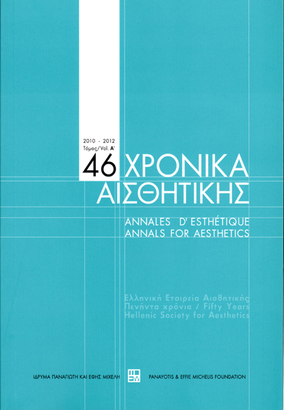Η αισθητική θεωρία του Κ. Μ. Κούμα
Part of : Χρονικά αισθητικής : ετήσιον δελτίον της Ελληνικής Εταιρείας Αισθητικής ; Vol.27-28, No.1, 1988, pages 129-156
Issue:
Pages:
129-156
Parallel Title:
The aesthetic theory of K.M. Koumas
Author:
Abstract:
This paper deals with K.M. Koumas’ aesthetic theory and tries to evaluate it within the context of the European aesthetic traditions. It also points out the importance of Koumas’ effort to circulate among the Greek people during the Turkish occupation the new ideas which were current in Europe. Born in Larissa (Thessaly) Konstantinos Koumas (1777-1836) was educated locally and abroad (Vienna, Berlin and Leipzig). In Germany he had the opportunity to meet scholars such as Wolf, Buttmann, Thiersch, Greuzer, Voss and philosophers such as Krug and Schelling. He was a product of the Enlightenment and a follower of A. Koraes whose influence is to be seen both in his devotion to didactic activity and in his views about the language in which the instruction is to be presented. He encouraged the new learning inclusive of mathematics and science and was interested in philosophy and history. A learned and prolific writer in his main work of four volumes Σύνταγμα Φιλοσοφίας (1818-20), whose title may be paraphrased as Philosophy Drawn Up and Constituted, Koumas was successful in making known to his countrymen and disciples the Kantian philosophical system as interpreted through the philosophical works of Wilhelm Traugott Krug. Actually the latter followed Kant in the chair of logic and metaphysics at Königsberg after his death. An outwardly Kantian he reflects and symbolizes the aged Kant’s own attitude towards his idealistic followers. Koumas in his Aesthetics plagiarised Krug’s aesthetic theory and successfully discussed aesthetic problems expressed in it focusing his attention on several aesthetic concepts such as taste and genius, two notions considered to be almost identical in creativity, art, beauty and sublimity, aesthetic judgements, the classification of the aesthetic qualities and the systematisation of the arts.While he is not original, as he is following the non-idealistic aesthetics of Krug, his aesthetic theory is worthwhile since it contains insights into considerations that emerged in the course of preromantic and romantic aesthetics. The value of his aesthetics is based on the fact that he made a serious effort to present systematically new ideas about art and about criticism, in plain and understandable writing, at a time when aesthetic thinking was prevalent in Europe and philosophical concern with aesthetic problems persisted especially in Germany. On the other hand Koumas’ endeavour has to be evaluated as an effort to introduce to Greeks an aspect of the German aesthetic tradition, at a time when Greek scholars of the Neohellenic Enlightenment, at the beginning of 19th century, either showed their interest in aesthetic problems and criticism, following either the French or the Scottish aesthetic tradition, or they were not interested in aesthetics at all.
Subject:
Subject (LC):
Notes:
Αποτελεί ανακοίνωση στο Συνέδριο «Κ.Μ. Κούμας», που οργάνωσε στο Πνευματικό Κέντρο του Δήμου Αθηνών η Εταιρεία των Θεσσαλών (1986).




